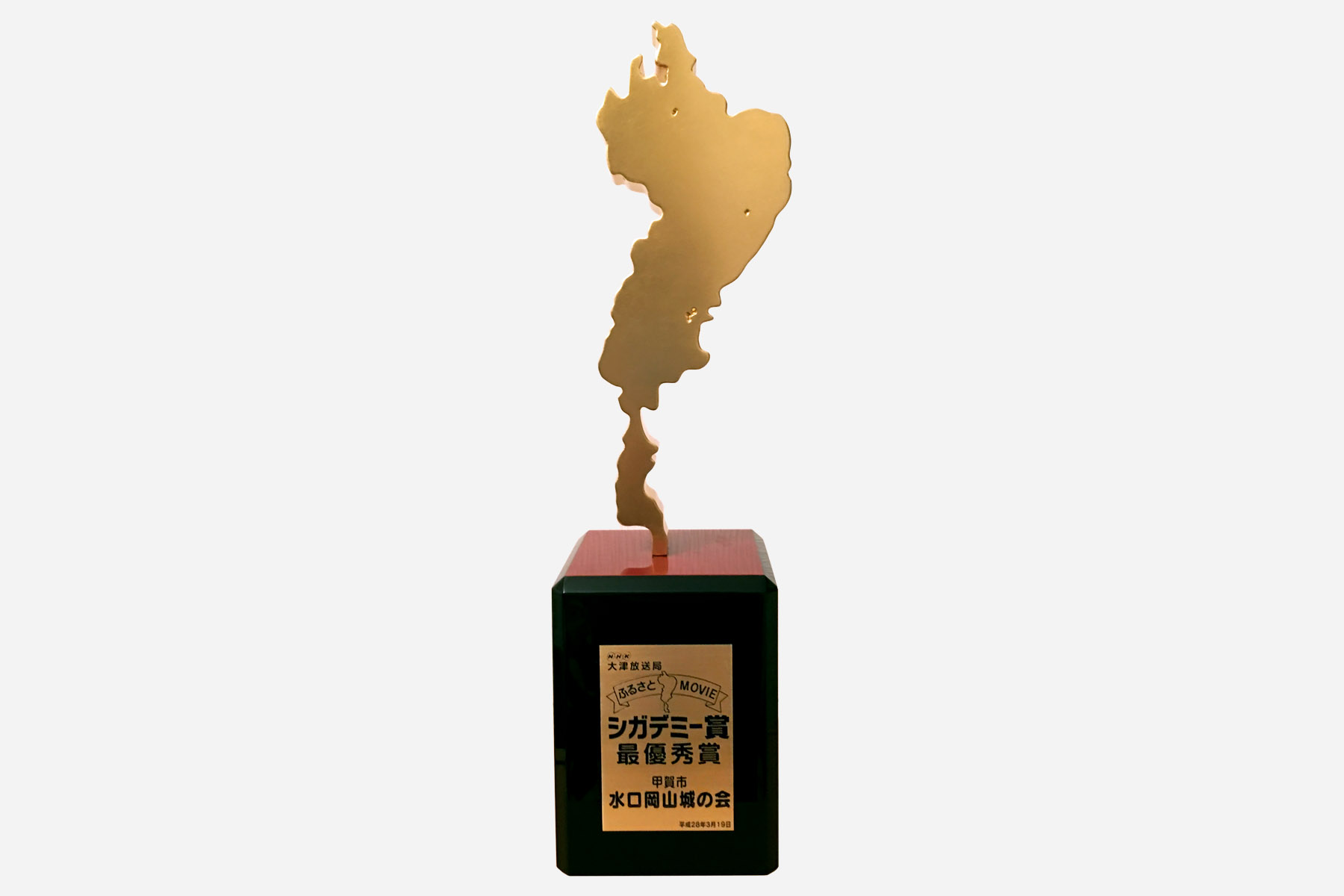Shiga-demy Awards Trophy

We created a trophy for the NHK Otsu Broadcasting Office’s “Hometown Movie Shiga-demy Awards.”
The upper part is cut into the shape of Lake Biwa and covered in gold leaf after being painted. The pedestal part is painted in lacquer and has an etched copper plate attached to it.
This colored lacquer is totally original and has been created by mixing lacquer and pigments after the order is received.
| Title | Shiga-demy Awards Trophy |
|---|---|
| Date | 2016.03 |
| Theme | Trophy/souveneir |
| Techniques | Woodworking, lacquering, finishing (cashew), etching, gold gilding |
| Materials | Hinoki, hiba wood, gold leaf, varnish, brass foil |
| Size | Width:120mm; depth:120mm; height:480mm |
| Client | NHK Otsu Broadcasting Station |
| Design | Ryo Ishikawa |
Integrated traditional materials and techniques
The pedestal is made of a large piece of hiba wood, while the figure of Lake Biwa is made of durable hinoki. The gold leaf is coated in varnish to protect it against being worn off.
Woodworking
Working with unfinished wood is an important initial process for creating the foundation or frame of a product.
Woodworking at INOUE is based on the exacting quality found in the traditional arts that have been cultivated by the production of Buddhist altars in the castle town of Hikone since the Edo Period (1603-1868 CE). Craftsmen produced these altars by hand and without nails, demanding uncompromising quality in the careful selection of the best materials for use in mortise and tenon construction. These altars are durable enough to be handed down through many generations. Furthermore, we have connections with woodworking shops in other areas that specialize in mass production, allowing us to select the appropriate methods of woodworking for any project.Lacquering
Lacquer is Japan’s exceptionally beautiful and high-quality traditional method of finishing. It is one of the most protective coatings in existence but can be very difficult to handle. Applying lacquer evenly requires the touch of a skillful craftsman from the first coat. The lacquer must be applied in many coats, from the first coat to the final finish, and the painting and polishing processes must be repeated many times over.
A high-gloss lacquer finish, considered the highest level of lacquer, involves the painted lacquer being polished flat, after which raw lacquer is repeatedly rubbed into the surface and polished to bring out a deep luster that is nearly mirror-like.
Based on our extensive knowledge of producing Buddhist altars, INOUE is able to offer the appropriate lacquering methods and craftsmen capable of implementing them, from a black, high-gloss lacquer finishes to a broad range of other coatings and lacquer colors.Gold plating (Hakuoshi, hakuhari, or hakuoki)
Hakuoshi is a decorative technique for covering items with gold or silver leaf or platinum foil.
While the material is called “gold leaf,” it includes a variety of types. These range from gold with a high degree of purity to silver admixtures that allow for an adjustment of the foil’s color. Techniques for applying the gold leaf include methods that bring out the luster of the foil as well as methods that create an elegant or refined appearance.
At INOUE, veteran craftsmen employ a wide variety of methods for gold leaf application. We have also developed techniques for the application of gold leaf to modern materials, such as acrylic resin and glass.Decorative fixtures (kazarikanagu)
While various types of metal fixtures are used in the arts, metalwork that is highly decorative in nature is called kazarikanagu. Metals such as brass or copper are used to fit the objectives and location of the fixture and various techniques are employed to shape the fixture, such as zibori to give the fixture a three-dimensional feel, kebori to engrave the fixture with fine lines and details, and sukashibori to create openings and provide a sense of depth. Other fixtures can also be produced through more cost-effective methods like metal pressing, electric casting, and etching.
We also provide the optimal techniques and decorative methods for adding finishes to kazarikanagu, such as gold plating, nickel plating or some other technique or combination thereof.Finishes (cashew, urethane, etc.)
At INOUE, the quality of our finishes is consistently and carefully scrutinized with a watchful eye. From sophisticated traditional techniques such as base coats of natural lacquer to cashew finishes made with the natural resin of the cashew tree, also a member of the lacquer family, to urethane finishes made with synthetic resins, we provide a wide variety of finishing techniques.
Given our extensive network of craftsmen with unparalleled technical skill, we can fulfill requests for finishes of nearly any kind.Gilding
Gilding is a surface processing technique that involves coating a target object, either metal or a non-metal such as plastic, with another metal. In the case of Buddhist altars, brass and copper surfaces are often gilded with gold or silver.